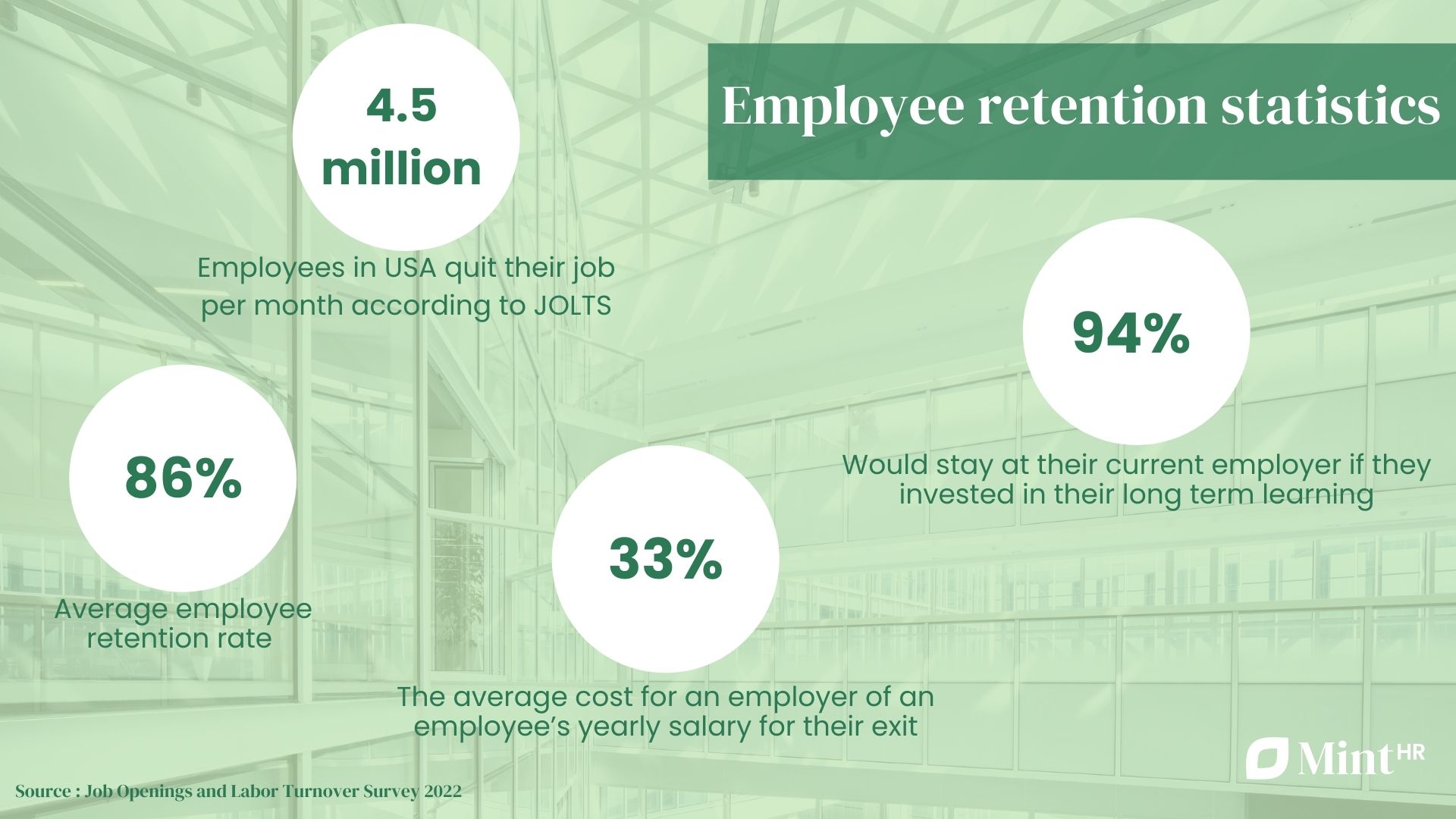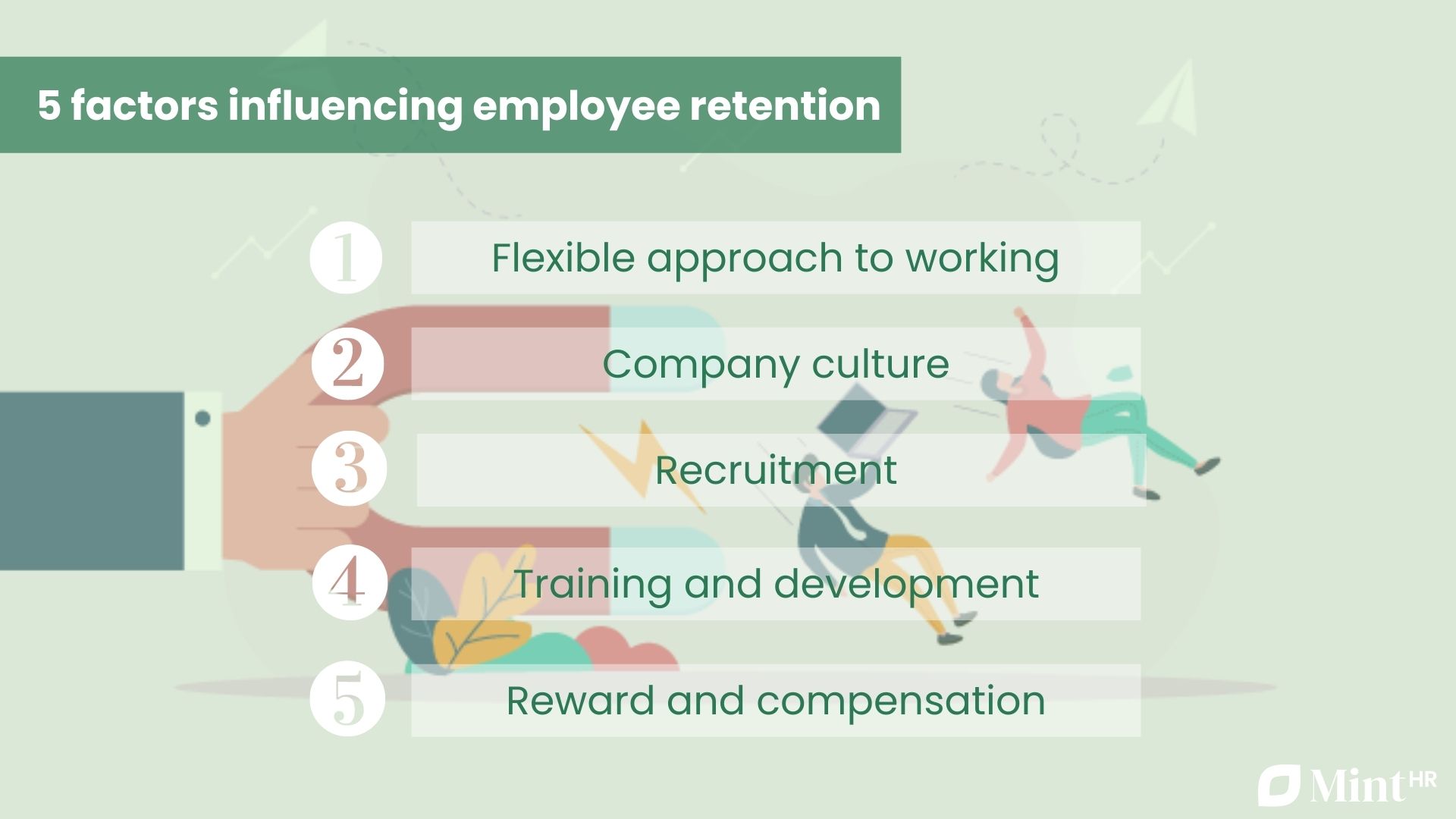Employee retention : 10 ways to boost your company’s rate

With terms such as ‘the great resignation’ on the rise, employee retention has never been so important. We all know that a company’s ability to hold onto talent affects its ability to perform. Employee retention rates have a direct impact on productivity, growth, and profitability.
The employee retention rate is the percentage of employees who stay with a company over a period of time. The average rate for all companies is currently around 86%. This means that, on average, 14% of employees leave their jobs every year.
Therefore, with good talent retention comes consistency, minimal disruption, and an environment where employees can perform to their best abilities.
At its simplest, improving your company’s retention rate is about giving employees fewer reasons to leave and find a new job. A successful employee retention strategy is about striking the right balance and finding a blend of factors that will make your employees stay where you want them – with you!
[Sommaire]
What is an employee retention rate?
Employee retention rate is the extent to which a company keeps its employees and is measured using a simple calculation:
Number of people employed over the stated time period ÷ number of people employed at the start of the stated time period x 100 = retention.
As an example, if you have 71 people employed over a year and 96 employed at the start of that period, your retention figure would be 74%.
(71 ÷ 96) x 100 = 74%.
It is important to include the correct number of employees in your figures. Only individuals who have been employed during the entire time period should be included.
This is to avoid any bias that could be caused by people joining or leaving the company part way through the stated time period. You should exclude people who were hired or left part-way through.
Some employee retention statistics you should know

The most common reasons employees leave their jobs are :
- Feeling unappreciated : 50% of employees who leave their jobs do so because they do not feel appreciated.
- Poor work-life balance : 43% of employees say that a poor work-life balance is the main reason they would leave their job.
- Feeling overworked and underpaid : 37% of employees cite this as a key reason for leaving.
- Lack of career development opportunities : 35% of employees say they would leave their job if they didn’t see any opportunity for growth.
- Poor management : 33% of employee turnover is due to bad management.
- Dissatisfaction with the company culture : 32% of employees say that a negative company culture would cause them to leave.
- Not feeling a sense of belonging : 31% of employees say that not feeling a sense of belonging is a reason they would leave their job.
- Stress : 29% of employees say that work-related stress is the main reason they would quit their job.
- Long hours : 28%of employees say that working long hours is a reason they would leave their job.
- Lack of flexibility : 26% of employees say that a lack of flexibility is the main reason they would leave their job.
What is a good employee retention rate ?
There is no magic retention figure. Although businesses might strive for as strong a retention figure as possible, it is essential to remember that a certain level of employee turnover is healthy for a business. If employees leave on only rare occasions, the business loses this opportunity.
When an employee leaves, the replacement employee can bring fresh ideas and expertise to the business. A high employee retention rate might also reflect a lack of development opportunities and could lead to a stagnant workforce.
A good employee retention rate is the one that strikes the perfect balance for your company – not too high and not too low. The best way to find this balance is to track employee turnover rates over time and compare them with industry norms.
The best way to judge the health of a company’s retention rate is to consider it:
Against industry standards :
Employee retention rates will differ from industry to industry. For example, in industries where employee turnover is traditionally high, such as retail and hospitality, a company with a retention rate of 80% might be doing very well.
However, in an industry where employee turnover is lower, such as healthcare or education, a company with the same retention rate might have a problem.
Against the company’s own history :
It is important to track employee turnover rates over time and compare them with the company’s own history. This will help you to identify any patterns and determine whether your current retention rate is good or bad
Comparing employee retention rates against the company’s own history can help identify whether there is an issue. If employee turnover has been increasing over time, then it is likely that the company’s retention rate is too low.
Against the employee’s expectations :
Another way to measure employee retention is to ask employees whether they are satisfied with their current job. This can be done through surveys or by asking managers to keep track of employee satisfaction levels.
If employee satisfaction levels are high and employees are not looking for other jobs, then the company’s retention rate is likely good. However, if employee satisfaction levels are low and employees are frequently looking for other jobs, then the company’s retention rate is likely too low.
Employees often have expectations about how long they will stay with a company. If their expectations are not met, they are more likely to leave. You can measure employee expectations by conducting exit interviews or surveys.
This will help to identify any disconnects between what the company offers and what the employee wants.
Against the employee’s needs :
Employees have different needs at different stages in their lives. For example, someone who has young children might need more flexible working hours, while someone who is close to retirement might not need any flexible working arrangements.
When employee needs are not being met, employees are more likely to leave their job. This can be tracked by conducting exit interviews with employees who have left the company.
If a high percentage of employees are leaving because their needs are not being met, then the company’s retention rate is likely too low.
Against the goals of the organization:
The goals of an organization will often determine the employee retention rate that is needed. For example, a company that is expanding rapidly will need to keep its employee retention rate high to avoid losing key staff.
Conversely, a downsizing or restructuring company might be happy with a lower employee retention rate. The organization's goals will also help determine what a good employee retention rate is. For example, if the goal is to increase innovation, then employee turnover might be seen as a positive thing.
Against the goals of the team :
The goals of a team can also be different from the goals of an organization. A team might have a lower employee retention rate than the organization because it is willing to let go of employees who are not a good fit.
A company that is trying to increase its employee retention rate might want to consider the goals of its teams.
Team goals can also be used to help judge whether a company’s employee retention rate is good or bad. If most of the team members share the same goal, such as developing their skills or working on a challenging project, then employee turnover could be bad for the team.
In relation to specific employee groups :
Employee retention rates can also be different for different employee groups. For example, a company might have a high retention rate for managers but a low retention rate for frontline employees.
It is important to track employee retention rates for different employee groups. This will help identify any problems and determine what needs to be done to improve employee retention.
It is also helpful to track employee retention rates for different groups within the company.
For example, you might want to look at employee retention rates for:
- New employees
- Employees with less than two years’ service
- Employees with more than five years’ service.
This will help you to identify any particular employee groups that are more likely to leave the company.
Against company performance in previous time periods :
A company’s employee retention rate can also be compared with its performance in previous time periods. This will help to identify whether the company’s current retention rate is good or bad.
Comparing employee retention rates against the company’s past performance can help identify whether there is an issue. If employee turnover has been increasing over time, then it is likely that the employee retention rate is too low.
Getting the same measurements is not always possible when reviewing industry (or even national) retention figures. However, turnover metrics provide similar – if not identical – information to help you understand the general themes.
What is the average employee retention rate ?
There is no one answer to this question, as employee retention rates vary from company to company. However, the employee retention rate is usually measured as the percentage of employees who are still with the company after a certain period.
For example, a company might track employee retention rates at 6, 12, and 24 months. This will help identify how many employees are leaving the company and when they are leaving.
The employee retention rate can also be measured as the percentage of employees who are still with the company after a certain time relative to the number of hired employees. This will help to identify whether the company is losing more employees than it is hiring.
It is believed that 90% is an average employee retention rate, but as the calculation is based on internal figures which companies may choose not to publish, this is difficult to verify.
There are a variety of ways to calculate employee retention rates. The most common calculation is to divide the number of employees who left in a given time period by the total number of employees at the beginning of that time period.
What is more important to understand is how your company’s retention rate compares vs. prior time periods. With this information, you can identify opportunities for improvement.
What are the factors that affect employee retention rate?

There’s no single tool that will improve the employee retention rate. Rather, retention rates are improved by creating a solid employee retention program.
Depending on its size and range of employee profiles, a company may need to have a series of employee retention programs.
To decide this, they must first create an employee retention strategy which should consider:
Recruitment
The recruitment process plays a big part in employee retention. It is important to hire the right people in the first place and ensure that they are a good fit for the company.
Once employees have been hired, it is essential to keep them engaged and motivated. This can be done by providing employee development opportunities and ensuring that they have a good work-life balance.
By hiring the right team members, a company will quickly build a business full of valuable employees who contribute to the company’s success.
Training and development
Professional development and ongoing education are crucial to employee motivation – from new employees to business leaders. When employees feel that they are constantly learning and growing, they are more likely to stay with the company.
Furthermore, employee development opportunities also help to improve employee productivity and innovation. A study by Bersin by Deloitte found that organizations with a solid employee-development program retained 87% of their employees, compared to 49% for those without a formal program.
Everyone should feel that they are learning. By building this into the employee retention strategy, a business can increase employee engagement and create highly skilled and motivated employees.
A flexible approach to working
Working flexibly has become an important factor for employees when considering a job offer. Employees want the option to work from home, take time off for personal reasons, or work different hours – as long as their work gets done.
A flexible approach to working is not only good for employee morale but can also lead to increased productivity. When employees are able to work in a way that suits them, they are less likely to feel stressed or overworked.
Flexible working arrangements can also help attract and retain talented employees who might otherwise leave for another job that offers more flexibility.
Supporting employees with flexible working practices works in more than one way. Flexible work can help a company retain employees by demonstrating trust in them and showing they understand employees’ individual needs. It can also support work-life balance, which can improve employee satisfaction.
Reward and compensation
It is no secret that employees like to be rewarded for their hard work. A study by Towers Watson found that employee recognition was the top reason employees gave for staying with their current company.
Employers should consider implementing a rewards and recognition program that is tailored to the company’s culture and employee demographics. This could include offering cash bonuses, gift cards, or employee of the month awards.
Alternatively, a company could offer non-financial rewards such as extra time off, a flexible working arrangement, or a parking spot.
The most important thing is that the rewards are meaningful to employees and consistently given. If employees feel that their hard work is not being recognized, they will quickly become demotivated and may consider leaving the company.
Compensation levels are always a factor in employee retention. That is because good pay makes employees feel valued. And employees who feel valued are employees who stay in their jobs for longer. It should not be the only factor used to prevent employee dissatisfaction, but if used well, pay and benefits may be able to prevent more than one departing employee.
Company culture
Company culture is one of the most critical factors in employee retention. Therefore a strong company culture encourages employee loyalty and can help reduce employee turnover.
When employee turnover is high, it can be costly for a company—replacing an employee costs on average 6 to 9 months’ worth of that employee’s salary, depending on the position.
A weak culture has a significant negative impact on retention. For this reason, investing in business culture should always be part of a business’s employee retention efforts. High-performing employees expect a company that values them and their team members – it is a long-term investment in a business. It plays a vital role in effective employee retention strategies.

What measures can companies use to improve their employee retention?
Ready to improve employee retention? Here are some best practices which will enhance employee engagement and reduce employee turnover.
1. Recruit with retention in mind
The hiring process is the first stage in ensuring good employee retention. Focus on applicants who have the right attitude and hire for culture add or culture fit.
This way, organizations can reduce high turnover and the associated training costs because the new team member will be more likely to stay in business.
2. Build a strong onboarding program
Well integrated into the recruitment program, the best employee retention strategies focus on welcoming new employees in such a way that they quickly feel part of the business. From training and ‘getting to know you’ tours to an introduction to company culture, an onboarding program is a key to ensuring more embedded employees and a successful employee retention strategy.
Consider whether it is right for managers to onboard their direct reports. Would it be better for a dedicated HR professional to lead onboarding and deliver a more consistent approach?
3. Create training that is tailored to employee needs
Personal development plans are an essential tool in retaining employees. By creating development opportunities that suit each employee, companies can increase employee engagement, reduce turnover costs and develop a team of good employees who understand best practices within your business.
This, in turn, helps improve company performance because they will have acquired high-performing team members – a key element in successful human resource management.
It is essential to ensure all employees can access training, including remote workers who may struggle with accessing centrally delivered training sessions.
4. Give employees clear and achievable career paths within your organization
The SHRM found that employees who were given opportunities to change roles within an organization were more likely to remain with it. It is easy to understand why.
By creating a career path for employees, a business provides a sense of job security and provides development opportunities that employees may otherwise not have had to access. It’s a great way of keeping top talent engaged and ensuring leadership development for those employees who will need these skills for the future.
5. Support flexible working for all employees
Thanks to the changes brought about by the Covid-19 Pandemic, it is now clear that flexible working does not need to be limited to working parents who have children to collect from school. Flexible working provides employees with a way to balance their professional and community life and support a healthy work-life balance.
What is more, since the pandemic struck, many companies are offering flexible work and options for remote employees. Companies that fail to do the same job market will see employees leave for jobs elsewhere with this job market.
6. Be generous
Competitive compensation is essential for businesses that want to retain employees. An employee’s salary affects employee morale and indicates how much a company values its employees.
It can be challenging to differentiate on pay alone – and it can quickly become unprofitable to do so. For this reason, other employee benefits can be helpful as well, as the next point shows.
7. Consider other benefits
As well as competitive pay, it is important for a company to think about other benefits that may appeal to employees and support employee retention. Health benefits such as insurance or access to a company doctor are very appealing to some.
Employee leave is also a popular option for helping employees create a healthier work-life balance and giving them the energy to do their best work when in the office.
8. Guarantee inclusion as well as diversity
Diversity and inclusion are a significant priority for many organizations. And has much as the hiring process needs to focus on ensuring diversity, it is an inclusion that can affect employee retention.
How can a business ensure inclusion for employees with protected characteristics? By slowing the turnover rate for these employees, you will also contribute to your company’s performance – McKinsey has found that more diverse teams consistently outperform those teams without good levels of diversity.
9. Support a feedback culture
Knowing they can give feedback to other employees and business leaders without negative consequences can be a powerful tool in supporting employee retention.
Not only does this create a more collaborative, supportive aspect of a company’s culture, but it also shows employees that business leaders value their input. This, in turn, shows they are valued employees who contribute towards the company’s success.
10. Consider the whole employee experience
To ensure highly engaged employees, it is essential to consider every aspect that can affect employee satisfaction. Employee motivation can be affected by many aspects; team culture, even the workplace set-up.
By reviewing the overall employee experience, a business can understand pressure points that may be contributing towards voluntary turnover.
The value of strong employee retention strategies
By following some or all of the ten tips above, your business can create an environment where employees want to stay and contribute to the company’s success.
While it is important to focus on the retention of your current employees, it is also crucial to consider the value of strong employee retention strategies. In order to keep your employees engaged and productive, you should focus on creating an environment where they feel valued.
Some of the ways you can do this include being competitive with pay, offering other employee benefits, guaranteeing inclusion, and supporting a feedback culture. By following some or all of these tips, you can create an environment where employees want to stay and contribute to the company’s success.
Conclusion
Retaining key employees might be a priority for business but is an ongoing challenge. For this reason, a strong retention process focuses on keeping current employees in their roles for the right reasons. If employees stay because they are too well paid to leave, this can damage long-term productivity as well as profitability.
The difficulty lies in striking the right balance – helping employees decide to stay with a company because they see a future for themselves in your organization, feel appreciated and get job satisfaction from doing their job.
Discover similar articles
Retain your best talent
by offering them a better experience !
Ready to streamline your HR & IT processes?



